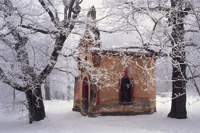Klaudia Buganová
The existence of small sacral buildings can often be spotted from a distance by large trees. Indeed, a tree or group of trees are very good indicators when searching for such buildings. The trees were in respect of Slavic ancestors. They believed that the souls of the dead are inside the trees, forever alive and maturing, and they see the manifestation of eternal life. The individual types of trees possessed certain characteristics. By accepting Christianity, pagan customs of worshiping trees ceased, and cult places were adapted to come into line with the new religion. Trees started to symbolize all a religious person regarded as sacred. In the name of tradition, trees started to be planted around churches, smaller chapels, shrines and crosses. The development of building small sacral buildings started mainly in Baroque times, which as a building style was characterised by a strong sense of symmetry. Significant emphasis was placed on harmonically complementing the natural picture. As small sacral buildings were symmetrical with a cross atop, the surroundings also needed to be symmetrical. It was important that planted trees added to the natural environment. These small buildings were not usually leading artistic or stylistic works. Simple burgesses, farmers or miners most often commissioned such small sacral buildings. Trees and greenery are an inseparable part of small sacral architecture. From the point of view of tree type appearing close to sacral buildings, leafy trees prevail, mainly linden trees. Coniferous trees only started to be planted in the interwar period of the twentieth century. Chapels, shrines, road and mountain crosses became part of regional cultural heritage. If they still appear in the country, they are a proof that they have not yet been forgotten.
